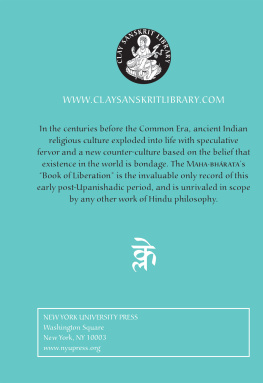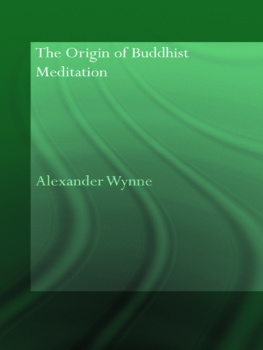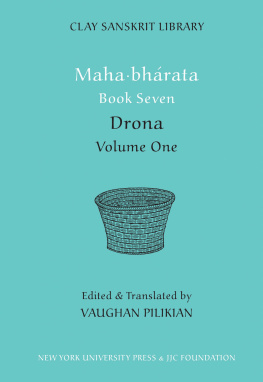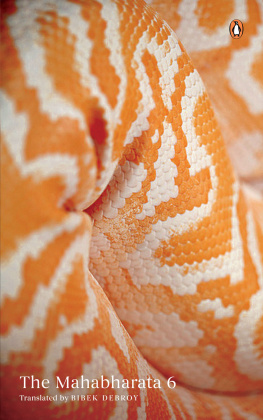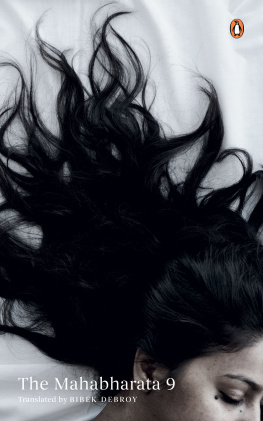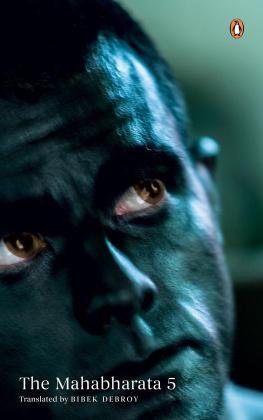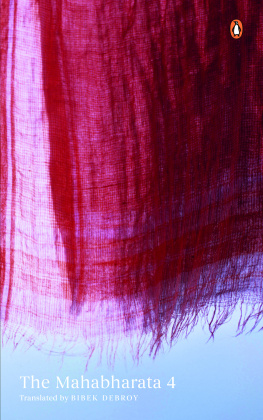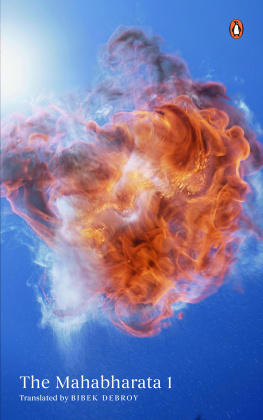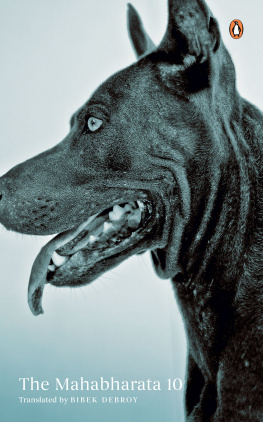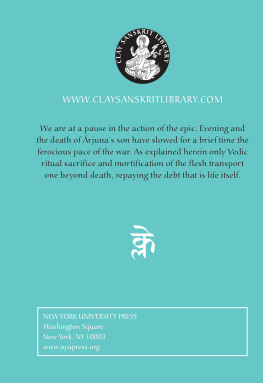Table of Contents
Guide
Artwork by Robert Beer.
Typeset in Adobe Garamond Pro at 10.25 : 12.3 +pt.
XML-development by Stuart Brown.
Editorial input from Daniel Balogh, Adam Bowles,
Ridi Faruque, Chris Gibbons,
Tomoyuki Kono & Eszter Somogyi.
Printed and bound in Great Britain by
T.J. International, Cornwall, on acid-free paper.
Copyright 2009 by the CSL
All rights reserved.
First Edition 2009
The Clay Sanskrit Library is co-published by
New York University Press
and the JJC Foundation.
Further information about this volume
and the rest of the Clay Sanskrit Library
is available at the end of this book
and on the following websites:
www.claysanskritlibrary.com
www.nyupress.org
ISBN- 13: 978-0-8147-9453-1 (cloth : alk. paper)
ISBN- 10: 0-8147-9453 -x (cloth : alk. paper)
Library of Congress Cataloging-in-Publication Data
Mahabharata. Santiparva. English & Sanskrit.
Mahabhrata. Book twelve, Peace. -- st ed.
p. cm.
Epic poetry.
In English and Sanskrit (romanized) on facing pages;
includes translation from Sanskrit.
Description based on: v. 3, published in 2009.
ISBN- 13: 978-0-8147-9453-1 (cl : alk. paper)
ISBN- 10: 0-8147-9453 -x (cl : alk. paper)
. Epic poetry, Sanskrit--Translations into English.
I. Wynne, Alexander, 1974 - II. Title. III. Title: Peace.
BL 1138.242 .SE 5 2009
294.5'92304521--dc22
2008049541
CONTENTS
MAHABHARATA XII PEACE III
THE BOOK OF LIBERATION
The Dialogue between King Senajit
and a Wandering Brahmin
The Dialogue between a Father
and his Son
The Dialogue between Ajagara and
Prahrada
The Dialogue between Kashyapa
and a Jackal
182192 The Dialogue between Bhrigu and
Bharadvaja
A Discourse on the Brahminic Rules
of Conduct
A Discourse on the Discipline
of Meditation
196200 A Discourse on the Practice of
Quiet Recitation
201206 The Dialogue between Manu and
Brihaspati
A Discourse on the Origin of
Gods and Men
An Account of the Conflict between
Demons and Gods
210217 The Dialogue between a Master and
Pupil
The Dialogue between Indra and
Prahrada
The Dialogue between Indra and
Namuchi
Another Dialogue between Indra
and Bali
The Dialogue between Indra and
Shri
The Dialogue between Jaigishavya
and Asita
The Dialogue between Vasudeva
and Ugrasena
Sanskrit Alphabetical Order
Vowels:
Gutturals:
Palatals:
Retroflex:
Dentals:
Labials:
Semivowels:
Spirants:
Guide to Sanskrit Pronunciation
b u t
f a ther
s i t
f ee
p u t
b oo
vocalic r , American p ur-
dy or English p re tty
lengthened r
vocalic l , ab le
m a de, esp. in Welsh pro
nunciation
b i te
r o pe, esp. Welsh pronun
ciation; Italian s o lo
s ou nd
anusvara nasalizes the pre
ceding vowel
visarga , a voiceless aspira- tion (resembling the En- glish h ), or like Scottish ________
lo ch, or an aspiration with a faint echoing of the last element of the preceding vowel so that taih is pronounced taihi
lu ck
blo ckh ead
g o
bi gh ead
a n ger
ch ill
mat chh ead
j og
aspirated j, he dgeh og
ca ny on
retroflex t, t ry (with the tip of tongue turned up to touch the hard palate)
same as the preceding but
aspirated
retroflex d (with the tip
of tongue turned up to
touch the hard palate)
same as the preceding but
aspirated
retroflex n (with the tip
of tongue turned up to
French t out
ten t h ook
d inner
guil dh all
n ow
p ill
u ph eaval
b efore
a bh orrent
m ind
y es
trilled, resembling the Ita
lian pronunciation of r
touch the hard palate)
l inger
w ord
sh ore
retroflex sh (with the tip of the tongue turned up to touch the hard palate)
hi ss
h ood
CSL Punctuation of English
The acute accent on Sanskrit words when they occur outside of the Sanskrit text itself, marks stress, e.g., Ramayana. It is not part of traditional Sanskrit orthography, transliteration, or transcription, but we supply it here to guide readers in the pronunciation of these unfamiliar words. Since no Sanskrit word is accented on the last syllable it is not necessary to accent disyllables, e.g., Rama.
The second CSL innovation designed to assist the reader in the pronunciation of lengthy unfamiliar words is to insert an unobtrusive middle dot between semantic word breaks in compound names (provided the word break does not fall on a vowel resulting from the fusion of two vowels), e.g., Mahabharata, but Ramayana (not Ramaayana). Our dot echoes the punctuating middle dot () found in the oldest surviving samples of written Indic, the Ashokan inscriptions of the third century bce .
The deep layering of Sanskrit narrative has also dictated that we use quotation marks only to announce the beginning and end of every direct speech, and not at the beginning of every paragraph.
CSL Punctuation of Sanskrit
The Sanskrit text is also punctuated, in accordance with the punctuation of the English translation. In mid-verse, the punctuation will not alter the sandhi or the scansion. Proper names are capitalized. Most Sanskrit meters have four feet ( pada ); where possible we print the common sloka meter on two lines. The capitalization of verse beginnings makes it easy for the reader to recognize longer meters where it is necessary to print the four metrical feet over four or eight lines. In the Sanskrit text, we use French Guillemets (e.g., kva samcicirsuh? ) instead of English quotation marks (e.g., Where are you off to?) to avoid confusion with the apostrophes used for vowel elision in sandhi.
SANDHI
Sanskrit presents the learner with a challenge: sandhi (euphonic combination). Sandhi means that when two words are joined in connected speech or writing (which in Sanskrit reflects speech), the last letter (or even letters) of the first word often changes; compare the way we pronounce the in the beginning and the end.
In Sanskrit the first letter of the second word may also change; and if both the last letter of the first word and the first letter of the second are vowels, they may fuse. This has a parallel in English: a nasal consonant is inserted between two vowels that would otherwise coalesce: a pear and an apple. Sanskrit vowel fusion may produce ambiguity.
The charts on the following pages give the full sandhi system.
Fortunately it is not necessary to know these changes in order to start reading Sanskrit. All that is important to know is the form of the second word without sandhi (pre-sandhi), so that it can be recognized or looked up in a dictionary. Therefore we are printing Sanskrit with a system of punctuation that will indicate, unambiguously, the original form of the second word, i.e., the form without sandhi. Such sandhi mostly concerns the fusion of two vowels.
In Sanskrit, vowels may be short or long and are written differently accordingly. We follow the general convention that a vowel with no mark above it is short. Other books mark a long vowel either with a bar called a macron ( a ) or with a circumflex ( a ). Our system uses the _______________

